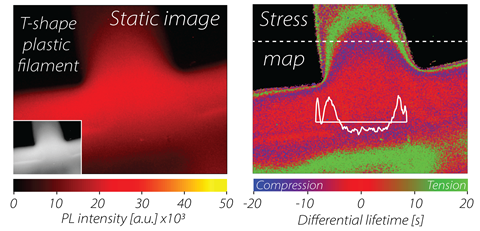Delft duo plots polymer stress at molecular level.
What happens at the molecular level when a polymer solidifies from its melt? Delft researchers Georgy Filonenko and Richard Janissen analyzed the mechanochemical response that occurs when a polymer hardens. They published their results on 12 December in JACS.
The researchers used spiropyrene (SP), a mechanophore, or molecule that emits light when you apply force to it. Spiropyrene changes under mechanical stress from colorless to the fluorescent isomer merocyanine (MC). That switch appears to be much easier in solid PMMA. Due to the internal stress in the polymer, the activation energy for this reversible isomerization changes from 140 kJ/mol in a liquid polymer to 70 kJ/mol in the solid form.
Next, Filonenko and Janissen used SP to observe the distribution of internal stress in PMMA at the molecular level. They combined spectroscopy with fluorescence imaging techniques, developing a relatively simple way to image local stresses in solid polymers. Filonenko: ’Engineers have a practical mindset. We built the measurement setup ourselves, so we could measure in a different way.’
Filonenko is an assistant professor of materials science at TU Delft. He is a chemist, but has previously published mechanical papers. ’This research was actually a loose idea, something that didn’t belong to any other line of research at all. My Veni had just ended, so I could think calmly about what I wanted to research next. This research was driven by curiosity, not a possible application. But I was pleasantly surprised with the results!
According to Filonenko, we can do more with conventional molecules than we think. He has since put his students to work. ‘I am convinced that the measurement method can be even easier, the only question is how. They can figure that out.’













Nog geen opmerkingen